| CORNUS
angustata 'Full Moon' There are a number of "minority" species whose exact classification is under debate. Some authorities consider them to be subspecies or geographical variants of C. kousa, whilst others attribute them to C. capitata. For now I have maintained them as individual species until their status is better understood. This one is fully evergreen even in our exposed conditions here. Similar in principle to C. kousa, the bracts mature a little later, so it is florally not at its peak until at least July. The creamy white bracts are huge, but the fruit which follow are massive by comparison to others in the group, often equalling or even exceeding the size of a golf ball. Since they are produced later in the season, they will ripen to red most effectively in a warm sunny site. See also C. capitata, C. elliptica 'First Choice' and C. emiensis. See it in our Quarry Garden. |
|
|
|
|
 |
CORNUS
'Ascona ' (C. florida x C. nuttallii) A small tree with gently pendulous branches. Thus it becomes clothed down to the ground with large white flower bracts in May. Vivid red autumn colour. See also the cultivars of Cornus nuttallii. |
|
|
|
| CORNUS
capitata The first thing you need to know about this spectacular species, is that although it comes from the Himalayas and China, it is not quite as hardy as the other species we have previously concentrated on. It is however, such a classic that we concluded we really need to make the effort. One of the problems is simply that it wants to be evergreen - and having leaf in winter makes it more vulnerable to cold and general exposure. Crucial therefore, to choose a sheltered site for it. In northern and colder climes, I would suggest that the risk is too great and you should consider instead one of the many cultivars of Cornus kousa. C. capitata flowers a little later, peaking in July instead of June, but the structure and beauty of the flower bracts is the same. The habit tends to be a little more shrubby and it doesn't get as big in the long term. A fantastic crop of large, juicy, strawberry-like fruit round-off the display in the autumn. |
|
|
|
|
| CORNUS
'Dorothy' (C. florida x C. nuttallii) I am indebted to Talon Buchholz for sharing this magical plant with me. He introduced it as part of his Flora Wonder(tm) Collection of Buchholz Nursery where it forms an upright deciduous tree to some 10' in 10 years. There are other well-know hybrids between these two parents of course, but they all sit happily at the nuttallii end of the scale. This one by contrast appears much closer to its florida parentage. The flower bracts are soft white near the centre with a warm pink edge. |
|
|
|
|
 |
CORNUS
'Eddies White Wonder' (C. florida x C. nuttallii) Just to further confuse matters, there are two forms of this popular plant. We offer the true American form, which is similar to C. 'Ascona' with its lightly pendulous habit. The other is much more upright and more akin to C. 'Ormonde'. Large white flower bracts in May, and fantastic red and orange autumn colour. See also the cultivars of Cornus nuttallii. |
|
|
|
|
CORNUS elliptica 'First Choice' We are grateful to Mark Weathington at JCRA for sharing this one with us. This is an evergreen variety, in our collection most similar to C. angustata 'Full Moon' yet visually very different, particularly in its foliage. This one has a bronze flush to the leaves, especially when they are young and they are almost glossy as they mature. The creamy bracts in July are very much as you would expect for the group. This is an exciting variant to add to the collection and I am looking forward to watching it develop. See it in our Woodland Walk. |
|
|
|
|
|
CORNUS emiensis There seems to be little information available about this one, which the RHS attribute to C. capitata. Perhaps that is the case, but visually it is poles apart. The foliage of our C. emiensis is a warm copper colour, richest in the young growth, but largely maintained through the year. It has a wonderful dense, cascading habit, thus naturally making a large shrub rather than attaining the proportions of a tree. The "flowers" share the typical 4-bracted structure of the group, though they tend to remain smaller and more star-like than many, further enhancing the grace of the plant. It is evergreen, so will benefit from a sheltered site, but it should be as hardy as other similar species like C. capitata and C. angustata. The original plant that I came across was in a large pot (though of course there is no obligation to grow it thus!) and although I would be more inclined to plant it in the garden in the normal way, it did make a very lovely specimen in a large container. See it in our Quarry Garden and Woodland Walk. |
|